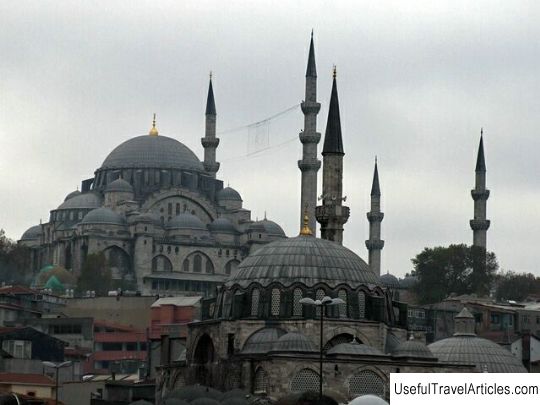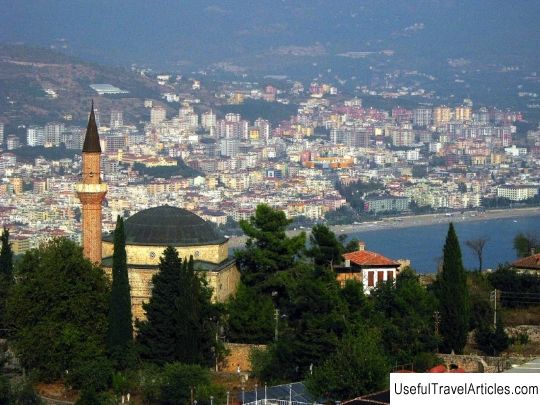Suleymaniye Camii Mosque description and photos - Turkey: Istanbul
Rating: 8,2/10 (8695 votes) 
Suleymaniye Camii Mosque description and photos - Turkey: Istanbul. Detailed information about the attraction. Description, photographs and a map showing the nearest significant objects. The title in English is Suleymaniye Camii. Photo and descriptionThe Suleiman Mosque was built in Istanbul by order of Sultan Suleiman the Magnificent and is truly considered one of the most outstanding architectural structures of the East. The time when Sultan Suleiman the Magnificent (1520-1566) ruled, historians called the Golden Age of Istanbul. The dominant force in world politics at that time was the Ottoman Empire, which was experiencing its heyday and reached the apogee like the Byzantine Empire during the reign of Justinian. For this reason, this period is considered the pinnacle of power in Turkish history. This mosque, located on one of the seven hills of the city and towering into the heavens, is considered a masterpiece of architectural art. The mosque was built by the architect Sinan. Construction began in 1550 and completed in 1557. Architect Sinan has been immortalized as " an architect who doesn't need an architectural layout. ” This outstanding famous architect worked in the years 1490-588, and for fifty years of his creation he was the chief court architect for five Turkish padishahs. He built about four hundred architectural monuments. In the work of Sinan, many similarities are found with the great Michelangelo. According to his designs, a madrasah in Mecca, a mosque in Budapest and many other structures were built. According to the legend, the construction of the mosque and the complex has been going on for 7 years. The mosque building is considered highly earthquake resistant. When the mosque was being opened, Sinan said, `` This mosque will last forever. '' The words of the famous architect are confirmed by the history of earthquakes that happened over 500 years. During this entire period, twenty-four important monuments, which were built by Sinan, did not suffer from 89 serious earthquakes of up to seven points on the Richter scale. The architect embodied the grandiose ideas of Suleiman the Magnificent. Built in 1550-1557, the mosque gave Istanbul a charm that nothing could compare. Sinan wrote in his autobiography that the temple of Hagia Sophia was the most important criterion for evaluating all the creations created by him. He always wanted to prove to everyone that "you can build better than the Greeks." The Suleiman Mosque was indeed the clearest proof that Sinan managed to surpass the architects who worked under Justinian. The building of the Sultan Suleiman Mosque is based on four columns. Above the pillars made of red granite, pointed arches, specially brought from Baalbek from the Hippodrome square, they connect the adjoining domed rooms with the main building. Above the mihrab there are half-domes (these are niches showing the direction to Mecca), which are in perfect harmony with the adjacent domed rooms. They thereby give freedom and emancipation to the entire surrounding building. The height of the mosque is 49.5 m, and the diameter of the dome is 26.2 m. Looking at the mosque, proudly rising on the hills, is especially pleasant from the side of the Bosphorus and Galata Bridge. Four minarets with ten balconies are the symbol of Sultan Suleiman the Magnificent, who was the tenth sultan of the Ottoman Empire ("the tenth son of Osman") and the fourth to ascend the throne after the conquest. The architect Sinan erected two minarets slightly shorter than the others. This is a brilliant solution which was intended to make the mosque built on the hill more harmonious. The complex of the great Suleymaniye mosque can be called a city within a city. In addition to the mosque itself, it includes a Koranic school, a Turkish bath, a caravanserai, a shelter, several hospitals, toilets, and artisans' malls. Particularly fascinating is the view of old plane trees and a small fountain. The floor in the mosque is covered with carpets, and inside it has good lighting - the light comes into it from one hundred and thirty-six expensive beautiful stained-glass windows decorated with ancient letters-quotes from the Koran. The calligraphic inscription on the dome reads: “Allah is the light of heaven and earth. Its light is like a niche; there is a lamp in it; glass lamp; glass is like a pearl star. It is ignited from the blessed tree - the olive, neither eastern nor western. Its oil is ready to ignite, even if the fire didn't touch him. Light in the world! Allah leads to his light whoever He wishes! ”. Behind the mosque there is a cemetery where Sultan Suleiman the Magnificent and his wife Khyurrem Sultan rest. Some Venetian wrote about Suleiman: "The Sultan was so in love and devoted to his wife that all those who were served were sure that Khyurrem Sultan had bewitched him." Khyurrem Sultan was a Slav. Among Istanbul Europeans, she was known as "Roxalana", and remained unapproachable to Suleiman until the sultan promised to marry her. A precedent of this kind never took place among the sultans of the Ottoman Empire. Not far from the Suleymaniye Mosque, at the intersection named after the architect, is the modest tomb of Sinan. Allah leads to his light whoever He wishes! ”.Behind the mosque there is a cemetery where Sultan Suleiman the Magnificent and his wife Khyurrem Sultan rest. Some Venetian wrote about Suleiman: "The Sultan was so in love and devoted to his wife that all those who were served were sure that Khyurrem Sultan had bewitched him." Khyurrem Sultan was a Slav. Among Istanbul Europeans, she was known as "Roxalana", and remained unapproachable to Suleiman until the sultan promised to marry her. A precedent of this kind never took place among the sultans of the Ottoman Empire. Not far from the Suleymaniye Mosque, at the intersection named after the architect, is the modest tomb of Sinan. Allah leads to his light whoever He wishes! ”.Behind the mosque there is a cemetery where Sultan Suleiman the Magnificent and his wife Khyurrem Sultan rest. Some Venetian wrote about Suleiman: "The Sultan was so in love and devoted to his wife that all those who were served were sure that Khyurrem Sultan had bewitched him." Khyurrem Sultan was a Slav. Among Istanbul Europeans, she was known as "Roxalana", and remained unapproachable to Suleiman until the sultan promised to marry her. A precedent of this kind never took place among the sultans of the Ottoman Empire. Not far from the Suleymaniye Mosque, at the intersection named after the architect, is the modest tomb of Sinan. where Sultan Suleiman the Magnificent and his wife Khyurrem Sultan rest. Some Venetian wrote about Suleiman: "The Sultan was so in love and devoted to his wife that all those who were served were sure that Khyurrem Sultan had bewitched him." Khyurrem Sultan was a Slav. Among Istanbul Europeans, she was known as "Roxalana", and remained unapproachable to Suleiman until the sultan promised to marry her. A precedent of this kind never took place among the sultans of the Ottoman Empire.Not far from the Suleymaniye Mosque, at the crossroads named after the architect, there is a modest tomb of Sinan. where Sultan Suleiman the Magnificent and his wife Khyurrem Sultan rest. Some Venetian wrote about Suleiman: "The Sultan was so in love and devoted to his wife that all those who were served were sure that Khyurrem Sultan had bewitched him." Khyurrem Sultan was a Slav. Among Istanbul Europeans, she was known as "Roxalana", and remained unapproachable to Suleiman until the sultan promised to marry her. A precedent of this kind never took place among the sultans of the Ottoman Empire.Not far from the Suleymaniye Mosque, at the intersection named after the architect, is the modest tomb of Sinan. Among Istanbul Europeans, she was known as "Roxalana", and remained unapproachable to Suleiman until the sultan promised to marry her. A precedent of this kind never took place among the sultans of the Ottoman Empire.Not far from the Suleymaniye Mosque, at the intersection named after the architect, is the modest tomb of Sinan. Among Istanbul Europeans, she was known as "Roxalana", and remained unapproachable to Suleiman until the sultan promised to marry her. A precedent of this kind never took place among the sultans of the Ottoman Empire.Not far from the Suleymaniye Mosque, at the crossroads named after the architect, there is a modest tomb of Sinan.                        We also recommend reading Church of St. Nicholas the Wonderworker in Kotelniki description and photos - Russia - Moscow: Moscow Topic: Suleymaniye Camii Mosque description and photos - Turkey: Istanbul. |




